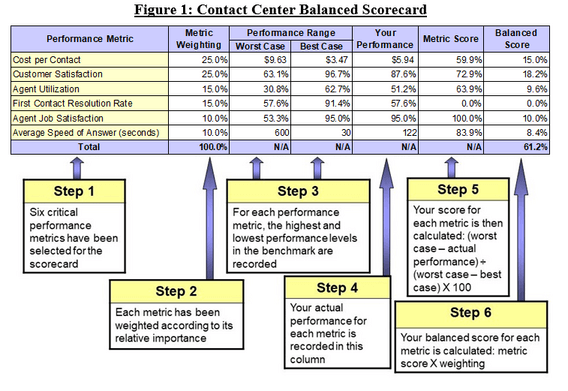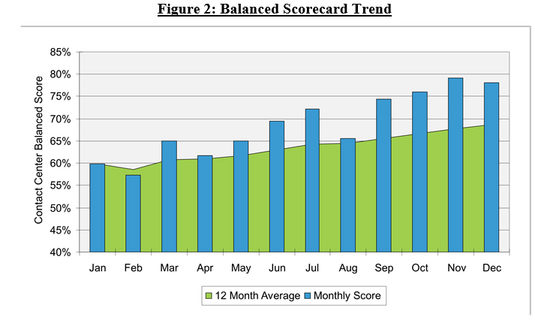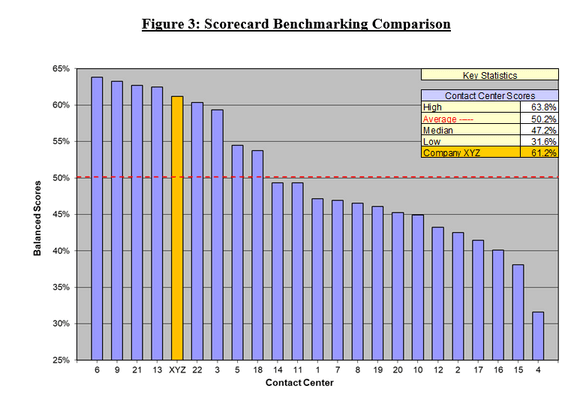By
Jeff Rumburg
|
Date Published: September 21, 2022 - Last Updated December 05, 2022
|
Comments
Best of ICMI in 2022 - #10
Each month MetricNet highlights one Key Performance Indicator for the Contact Center. We define the KPI, provide recent benchmarking data for the metric, and discuss key correlations, and cause-and-effect relationships for the metric. The purpose of the column is to familiarize you with the Key Performance Indicators that really matter to your organization, and to provide you with actionable insight on how to leverage these KPIs to improve your performance!
This month we depart from our usual format of discussing a single metric to explain how a handful of critical metrics can be combined to create a single, overall measure of contact center performance. We call this the contact center balanced scorecard.
The Balanced Scorecard
Today’s contact center technologies and reporting packages make it easy to capture copious amounts of performance data. Most contact center managers can tell you everything from last month’s average speed of answer to yesterday’s average handle time. But what does it all mean? If my abandonment rate goes up, but my cost per contact goes down, is that good or bad? Is my contact center performing better this month than it was last month?
Despite all the data that contact center managers have at their fingertips, most cannot answer a very basic question: How is my contact center performing? The balanced scorecard resolves this dilemma by combining the most important contact center KPIs into a single, overall measure of contact center performance.
MetricNet’s research shows that establishing a single, overall performance metric for your contact center is critical. We call this metric the balanced score because it truly does communicate a balanced picture of contact center performance. The balanced scorecard is a mechanism that aggregates the most important contact center metrics – such as cost per contact and customer satisfaction – into a single, all-inclusive measure of contact center performance. The value of this metric, when tracked over time, is that it enables you to determine whether overall performance is improving or getting worse. Moreover, it provides a useful benchmark for comparing your performance against other contact centers.
Oftentimes, when a contact center attempts to communicate its performance to other stakeholders in the business, particularly to lay people who do not understand contact center operations, those individuals quickly become overwhelmed by the minutia of such measures as speed of answer and call abandonment rate, and they are uncertain about how to interpret the results. They are likely to focus on one, easily-understood metric like speed of answer, and draw conclusions about overall contact center performance from this relatively unimportant metric.
This is a classic case of missing the forest for the trees. It is therefore absolutely critical to communicate the overall performance of the contact center, and the balanced scorecard does that for you.
Think of the balanced scorecard as your letter grade for the month. In this way, a contact center can track its overall performance; it may see costs go up or customer satisfaction go down or speed of answer increase, but these individual measures take on a secondary level of importance because the balanced score provides a more complete and accurate picture of overall contact center performance.
The Mechanics of Creating a Scorecard
Creating a balanced scorecard in Excel is relatively straightforward. You can follow along in Figure 1 below as I explain the process.

- First you select the metrics to include in your scorecard. We suggest including the following six metrics: cost per contact, customer satisfaction, agent utilization, first contact resolution rate, agent job satisfaction, and average speed of answer. Depending upon the metrics you track in your contact center, you may choose fewer metrics or a different mix of metrics for your scorecard.
- Secondly, you establish a weighting for each metric based upon its relative importance in the scorecard. This is a judgment call, but we suggest overweighting cost and customer satisfaction, since these are the foundation metrics for the contact center.
- Step 3 is to show a reasonable range of performance – worst case to best case – for each metric. Normally these performance ranges are derived from a benchmark of your contact center.
- In step 4 your performance for each metric is inserted into the third column from the right. A score for each metric is then calculated based on the interpolation formula in step 5.
- And finally, a balanced score for each metric is determined by multiplying the metric weighting by the metric score. When the balanced scores for each metric are summed up, you have the total balanced score for your contact center!
In this example, the contact center balanced score is 61.2%. Your balanced score will always range from 0% (if you have the worst possible performance for every metric in the scorecard) to 100% (if you have the best possible performance for every metric in the scorecard). It turns out that the contact center in our example has scored quite well. When we run hundreds of contact centers through this algorithm, we get a normal distribution centered right at 50%. Those who score above 60% are typically in the top quartile; those who score between 50% and 60% are in the second quartile; those between 40% and 50% are in the third quartile; and those below 40% are generally in the bottom quartile for overall contact center performance.
Benchmarking Your Performance
The balanced scorecard is an ideal way to track, trend, and benchmark your contact center performance. Figure 2 below shows the trend in one company’s contact center performance over a 12-month period. The blue bars in the chart represent the monthly balanced scores, while the purple background represents the 12-month trailing trend in scorecard performance. Clearly, the performance trend for this particular contact center is improving!

Finally, the contact center balanced score can be used to benchmark your contact center on a fair, apples-to-apples basis against other contact centers. Figure 3 below shows how the contact center in our example compares to 22 other contact centers in their benchmarking peer group.

Please join us for the next Metric of the Month: QSTAC, an emerging metric in the IT service and support industry.